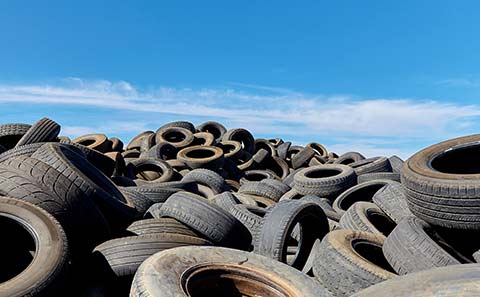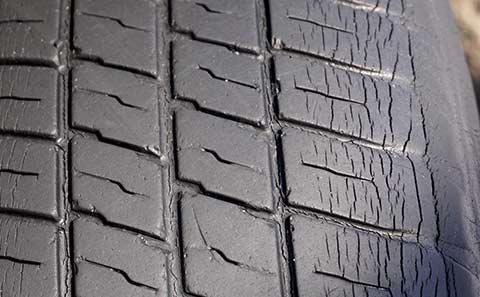Buying car tires is a hassle every vehicle owner has to face. Even the best quality tires will reach the end of their lifespan sooner or later. Different tires for car applications will offer distinct characteristics, and therefore varying service lives.
There are several things you can do to lengthen the periods between tire shopping seasons. But, when the time comes to look for a new car tire set, follow these crucial steps:
- Find the correct tire size (in the owner’s manual or the driver-side door jamb)
- The tire size includes the tire width, aspect ratio, and rim diameter
- The load index shows the overall load durability of a tire
- Speed rating on tires for your car indicates its max speed capacity
- If possible, buy tires in sets of four
What to Look For When Buying Tires for a Car?
The best tire to buy will depend on your driving needs. Even if you purchase high-quality tires, they might not be the right fit for you. To put it simply, the answer to “What to look for in tires?” is influenced by driving style and budget.
Whether you need higher comfort levels, better fuel economy, or some extra off-road traction, will greatly alter the outcome. If you are looking for some tire advice, we can only recommend getting tires that fit your vehicle, not just based on size, but also based on its performance.
Different tire brands and various tire types offer versatile handling, durability, and traction. You cannot mount high performance tires on a vehicle in frequent off-road applications. We will talk about it in more detail in our tire type chart later.
Tire Size and Other Key Requirements
When looking for new automobile tires, it is important to know the basics. Mainly, what size you need, along with other key characteristics most tires feature.
Unless you own a vehicle with staggered tires, you should buy all four tires in the same size. But, what do you need to know about buying tires when it comes to these key features?
Tire size, speed ratings, and tread life are the most important aspects to look at when buying a tire for your car.
Need a car tire buying guide? We have it right here!
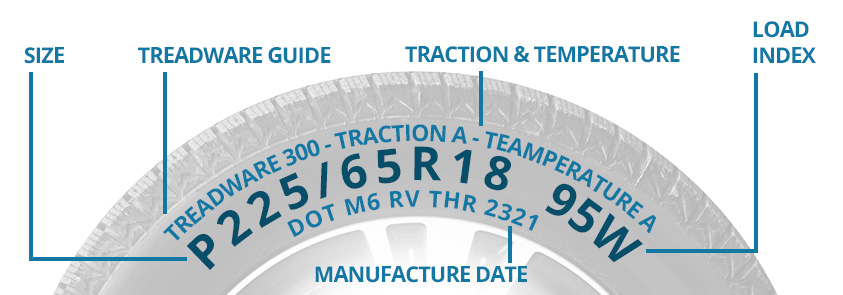
Tire Size Compatibility
Tire size consists of width, aspect ratio, and rim diameter. It is crucial to get the correct tire size to ensure your vehicle’s secure performance. These three numbers are the most important when buying new tires.
The first is a 3-digit number, showing the tire’s width from shoulder to shoulder in millimeters. The second number represents the percentage between the sidewall height and the tire width. Lastly, the rim diameter is the width of the rims in inches.
With most passenger car tires and light truck tires, you will see the letter R between the second and third numbers. This stands for Radial, which indicates the tire’s specific ply structure.
Some light truck and specialty trailer tires can also have bias-ply structures. In those cases, there will be a dash (-) between the last two sets of numbers. For more information, check out our blog about different belted tires.
Tire Speed Rating
Each tire is designed with a load and speed rating. These are located after the tire size on the sidewall, and represent the load and speed durability of the specific tire.
So, which tires are the best when it comes to speed rating?
The answer is: it depends. It depends on the needs of your vehicle and your driving habits. The speed rating is represented by a letter, starting with A. The larger the letter (looking at it alphabetically) the higher the speed rating – with the exception of H, which for some reason comes after U.
By comparing tires, we can see that high performance tires have stronger speed ratings than touring or off-road tires. For the full speed rating chart, take a look at our Tire Speed Ratings 101 blog.
UTQG Ratings on Tires
No tire guide is complete without mentioning the UTQG, or temperature, traction, and treadwear rating of a tire. If you wish to know what tires to buy, looking at this rating is essential.
Firstly, the temperature rating shows the heat durability of the tire. Its traction determines the tire’s controllability and braking capability. The treadwear rating is a number that represents the estimated tread life of each tire.
While this treadwear number is a good start, it is not always accurate. It approximates the tread life of a tire, but a better way to determine how long a tire will last is the treadwear or mileage warranty. A good tire brand will offer at least a minimal warranty with their model, but this is not the golden rule. For example, off-road and high performance tires will rarely be sold with such warranties.
Different Types of Tire
So, how to buy tires for your car or light truck?
The answer would ideally not be complicated, but sadly there are just too many tire types to choose from. Tips on buying tires should not be complete without mentioning the various tires available for purchase.
Drivers should be aware of the differences between tires in order to select the correct ones. Tire quality should not be an afterthought, even the best tire deals are only good if you get the correct tires.
What to know when buying tires? Think of this as Tire Types 101 or a short tire shopping guide.
All Season Tires
When you want to replace your tires, all season tires will probably be your first choice. These models are the most popular on the market and are often offered with the best tire prices.
All season tires are molded from rubber compounds that maintain their flexibility. They keep the tire pliable in both cold and warm temperatures. Their tread pattern features wide grooves and moderately detailed tread elements, which provide the needed traction. All season tires are a popular choice when it comes to grand touring passenger car tire sets.
Typically, good-quality tires in this category will provide excellent comfort levels, higher fuel efficiency, and a lengthened tread life. Buying new car tires that offer all season traction, gives the vehicle excellent performance in most weather conditions.
Performance and High Performance All Season Tires
Yes, all season tires can also offer good high speed durability. If you are in need of better handling, performance all season tires might be the best choice for you.
These tires offer the same characteristics as grand touring models do, some in a slightly diminished manner. Such a model is not the best quality tire when it comes to fuel efficiency, comfort levels, or tread life. But, they provide additional controllability and high speed durability.
Summer Tires
Most summer tires offer excellent dry and wet-weather traction. When searching for the best deal for tires, summer tires might end up on your shopping list.
These tires are often designed with asymmetric tread patterns. Tire brands model these designs using heat-resistant compound blends. This results in the tires’ superb hot weather performance. The footprint’s better road-to-rubber ratio generates traction, while the compound avoids pressure accumulation.
Hydroplaning resistance is also a strong characteristic such tires offer. Summer tires sport wide grooves that channel water away from the footprint. This optimizes surface contact, even on wet roads. But, they are not for winter use!
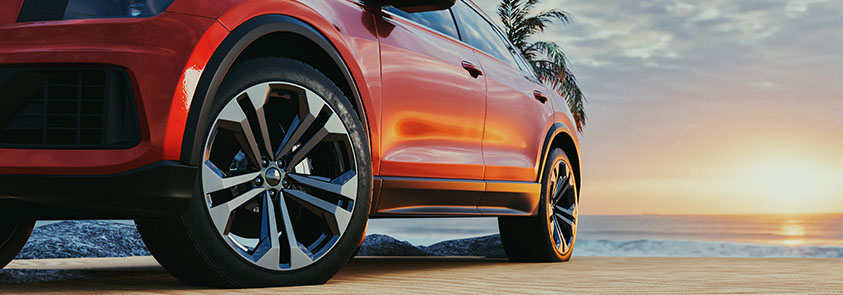
Performance and High Performance Summer Tires
The best tires for sports cars are considered to be high performance summer tires. They are the best tires for handling and the best tires for speed. Also, most summer tires fall into the performance of high performance tire category. Purchasing tires for sports cars means drivers are looking for high speed durability and excellent controllability.
This is exactly what such tires offer. A sports car tire combats pressure or heat accumulation along the footprint. Furthermore, their internal structure does not allow the optimal tire shape to deform, enhancing its high speed capacity.
Winter Tires and Snow Tires
Shopping for tires becomes harder when you are looking for a specific tire type. Yet, spending the time to research winter tires. The best traction tires, or winter models, offer the road grip needed even on ice- and snow-covered roads.
Winter tires feature detailed footprints. Their ideal groove and block placements create a directional or asymmetric tread pattern – depending on the specific tire model. The high-void ratio creates biting edges able to grip the road even in harsh winter conditions. These type of tires for cars avoids hydroplaning and guarantees great winter-weather driving safety.
The only problem with winter tires is that they do not perform well in warmer weather. When temperatures drop below 45 degrees Fahrenheit, winter tires lose their grip and are prone to excessive treadwear. Snow or winter tires feature the three peak mountain and snowflake (3PMS) symbol on their sidewalls.
Performance Winter and Snow Tires
The best tires for performance in winter conditions maintain the tire’s pliability in freezing temperatures. As winter tires are designed for cold weather, heat build-up is not really a problem they face.
However, the faster the tire spins the more heat accumulates on its footprint. This can deform its shape or cause tire failure. Still, thanks to modern tire technologies, tire brands manufacture safe and durable performance tires for snow applications.
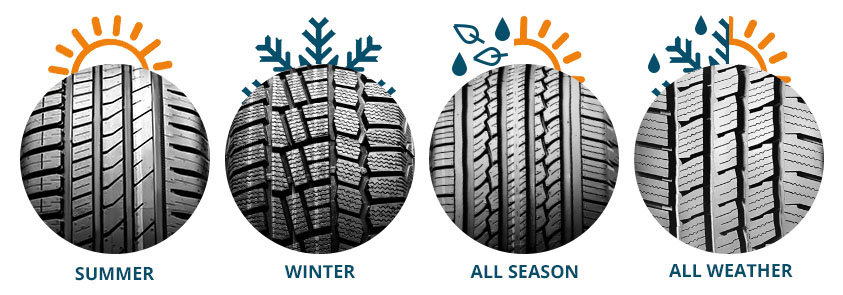
All Weather Tires
The true all around tire is the all weather tire. This is a relatively new tire category, that mainly features commercial tires currently. However, such passenger car tires are slowly appearing on the tire market.
All weather tires are a hybrid between winter/snow and all season tires. They offer excellent year-round traction as all season tires do. But, they also feature the 3PMS symbol, which indicates their harsh winter weather durability. When it comes to which tire is better, all weather models are often considered the best new tires available.
You won’t see these tires often in a tire buying guide, but they are worth the hype.
All Terrain Tires
Off-road enthusiasts need better tires, which are able to handle different driving surfaces. There are various types of off-road tires, but all terrain tires are the most widespread.
All terrain tires can be found for passenger car applications, which offer good gravel road performance. Yet, you can also easily locate SUV and light truck all terrain models. These offer stronger traction, being able to conquer soft, loose, and uneven terrains with ease.
Aggressive footprints, staggered block placement, reinforced structures, and durable compound ensure the performance of all terrain tires. With their combination, drivers can rest assured that their all terrain tire set will handle what’s thrown at it.
These tires are durable, offering a safer driving experience. So, if you often drive your vehicle off-road, investing in a good all terrain set is probably the best decision you can make.

Spare Tires
When talking about tips for buying tires, we should also mention spare tires. Now, if you have run flat tires, you don’t need a spare. But, in all other instances, it is good to have one.
There are different types of spare tires available. The most popular ones are the temporary spare and the full-sized spare. Both versions have their pros and cons, so picking the perfect one for your vehicle should not be a problem.
Need help in choosing the right spare tire? Let TireMart.com help!
Trailer Tires
ST or special trailer tires are designed for free-rolling axles. In other words, for trailers that are towed behind a vehicle. Therefore, they need specific tires that are able to handle the different pressures placed on them during the drive.
The main purchase of such tires is load durability. They feature stronger structures that do not deform under load and driving pressure. Instead, they handle versatile loads with ease.
Trailer tires are designed to follow the towing vehicle. They only need to offer adequate traction in varying temperatures. Yet, the biggest issue such tires face is heat accumulation. Trailer tires are prone to blowouts and it is important to choose the correct load durability for your needs.
When you purchase the correct trailer tires, they ensure both durability and stability.
Run Flat Tires
When contemplating which tires to buy, run flat tires are also a good option. Some car manufacturers equip their models with RFT tires in the factory. But, what are run flat tires?
These tires offer limited and temporary performance in case of air pressure loss. In other words, the vehicle will not be stranded on the side of the road. They help eliminate the use of a spare tire and free up much-needed trunk space.
However, you can also replace your tires from run flat to traditional ones. All you need to keep in mind is that you will need a spare tire… which can be an issue with various performance vehicles.
The opposite is also true! If you wish to equip your vehicle with RFTs, there won’t be any issues. All vehicles manufactured in the U.S. after 2008 must have a tire pressure monitoring system, which is crucial if you want to run these tires on your car.
Does Tire Brand Matter?
Now that you know how to buy new tires for your car, let’s talk about tire brands.
Each tire guide online will tell you a list of specific tire brands they offer. But, the best tire price might not be on those lists.
Whether you are looking for all season tires or something different, you will face an abundance of different models available for purchase. Top-tier tire brands used to be the way to go, but in recent years many budget-friendly options have popped up as well.
So, we would say that tire brand does not matter as long as you get the tires that fit your vehicle and your driving needs.
Frequently Asked Questions
Where Can I Buy a Tire?
You can buy a new tire online quite easily. Websites like TireMart.com have emerged in recent years, offering a comfortable alternative to visiting the tire shop. Now, customers can purchase tires from the comfort of their homes and have them shipped to their doorstep or to their preferred installer.
Who Makes the Best Tires?
The best tire brands currently manufactured are Michelin, Goodyear, Bridgestone, Continental, and Pirelli. They are the top five brands in the tire world. However, in recent years, lesser-known brands have become more popular, as they offer similar quality tire models at lower prices.
What are Good Tire Brands?
Top-tire brands are usually considered to be good tires to buy. However, high prices don’t always equal quality. Instead of searching for pricey tires, try to find mid-tier brands that offer exceptional traction, performance, and durability. Such tire brands are Cooper, General, Hankook, and Firestone.
What Is the Best Cheap Tire Brand?
There are multiple cheap tires drivers can choose from. While the cheapest tire brand might not offer the performance you need, it is worth exploring the realm of budget-friendly tires. Lower-priced tire brands that offer good traction are Venom Power, Fullway, and Haida, among others.
What Are the Best Tires for My Car?
What the right tire set for your car is will greatly depend on what vehicle you are driving. For this reason, you need to know which tire size fits your car. Once you have this information, you can start narrowing down tire selections based on the season, performance, budget, and tread life.
